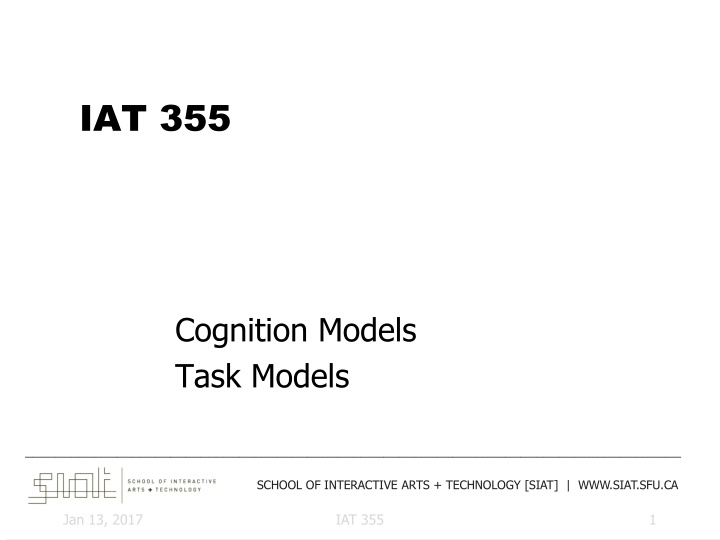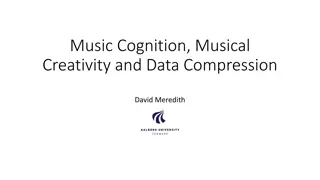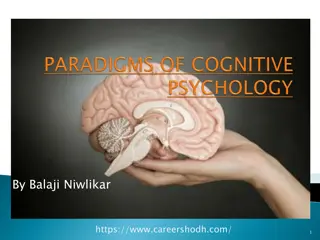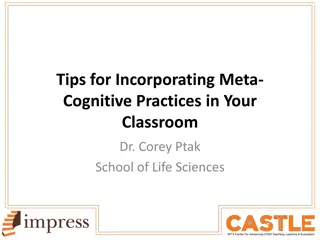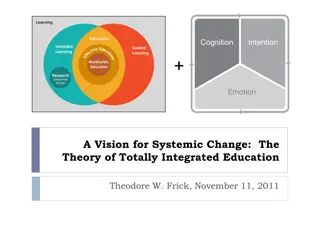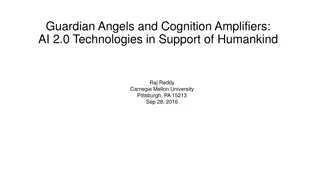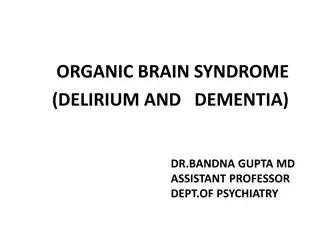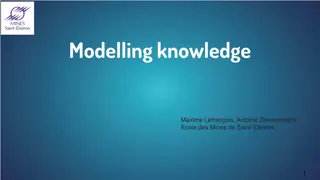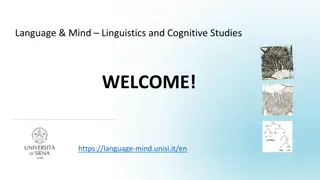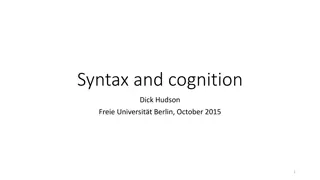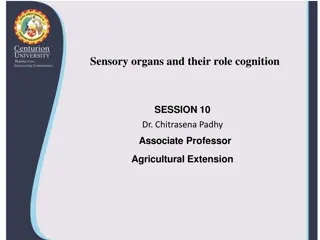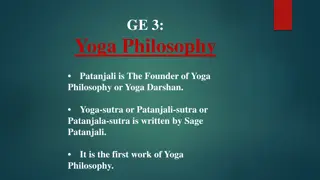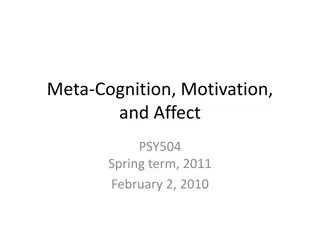Cognition Models in InfoVis: Understanding Knowledge Creation Process
Visualization plays a key role in aiding cognition by supporting knowledge creation and seeking tasks through process models and task taxonomies. Understanding the cognitive aspects of information visualization is crucial for aiding comprehension and knowledge understanding, as demonstrated by the use of graphics and internal cognitive maps. This article explores how graphic displays and cognitive models help users refine their internal understanding of systems, showcasing the importance of visualization in facilitating efficient task performance.
Download Presentation

Please find below an Image/Link to download the presentation.
The content on the website is provided AS IS for your information and personal use only. It may not be sold, licensed, or shared on other websites without obtaining consent from the author.If you encounter any issues during the download, it is possible that the publisher has removed the file from their server.
You are allowed to download the files provided on this website for personal or commercial use, subject to the condition that they are used lawfully. All files are the property of their respective owners.
The content on the website is provided AS IS for your information and personal use only. It may not be sold, licensed, or shared on other websites without obtaining consent from the author.
E N D
Presentation Transcript
IAT 355 Cognition Models Task Models ______________________________________________________________________________________ SCHOOL OF INTERACTIVE ARTS + TECHNOLOGY [SIAT] | WWW.SIAT.SFU.CA Jan 13, 2017 IAT 355 1
Cognition Summary Visualization Helps Cognition Aids the user by: Helping Knowledge creation process Helping with knowledge seeking tasks Models: Process models Task taxonomies Jan 13, 2017 IAT 355 2
Basic Premise Understanding (the cognitive aspects) is the crucial part of InfoVis Visualization is simply a tool useful for aiding comprehension and understanding Jan 13, 2017 IAT 355 3
How Are Graphics Used? Larkin & Simon 87 investigated usefulness of graphical displays Graphical visualization could support more efficient task performance by: Allowing substitution of rapid perceptual influences for difficult logical inferences Reducing search for information required for task completion (Sometimes text is better, however) Jan 13, 2017 IAT 355 4
Understanding People utilize an internal model that is generated based on what is observed B. Tversky calls the internal model a cognitive map Think about that term Jan 13, 2017 IAT 355 5
Example You re taking the SkyTrain to get to ScienceWorld You have some existing internal model of the system, stops, how to get there On train, you glance at map for help Refines your internal model, clarifying items and extending it Note that it s still not perfect, no internal model ever is Jan 13, 2017 IAT 355 6
Question Which direction do you drive to get from Windsor, Ontario to Detroit, Michigan? Jan 13, 2017 IAT 355 7
Answer: North Which direction do you drive to get from Windsor, Ontario to Detroit, Michigan? Jan 13, 2017 IAT 355 8
Windsor/Detroit If you answered West, you likely used this mental map: Michigan is West of Ontario, thus Detroit is west of Windsor If you answered South, likely you reasoned that Ontario/Canada is North of Michigan/USA Jan 13, 2017 IAT 355 9
Cognitive Map Just don t have one big one Have large number of these for all different kinds of things Collection of cognitive maps --> Cognitive collage Jan 13, 2017 IAT 355 10
Cognitive Collage A visualization system should clarify a part of your cognitive map of the world Correct and re-establish details when necessary Details on demand Jan 13, 2017 IAT 355 11
Process Models Process by which a person looks at a graphic and makes some use of it A number of substeps probably exist Can you describe process? Jan 13, 2017 IAT 355 12
Don Normans Action Cycle Goal Two Gulfs to be bridged by cognitive activity Gulf of Execution What do I do to change the display? Gulf of Evaluation How do I interpret the display? Form Intention Evaluation Gulf of execution Gulf of evaluation Form Action plan Interpretation Execute Action Perception Change in World Jan 13, 2017 IAT 355 13
Process Model Robert Spence Navigation- Creation and interpretation of an internal mental model Jan 13, 2017 IAT 355 14
Navigation Jan 13, 2017 IAT 355 15
Interpretation Content is the display on screen Modeling of that pattern results in cognitive map Interpretation (ah, variables x and y are related) leads to new view, that generates an idea for a new browsing strategy Look at the display again with that idea in mind Jan 13, 2017 IAT 355 16
Example (a) (b) (c) Figure 5.15 As the range of S4 is moved to higher values, the corresponding values of S3 move to lower values, indicating a trade-off Jan 13, 2017 IAT 355 17
Example Video v5attributeexplorer Jan 13, 2017 IAT 355 18
HIGHER-ORDER COGNITIVE PROCESSES of data REPRESENTATION Problem (re)formulation Evaluation of options DATA Strategy formulation of the PRESENTATION represented data PERCEPTION Internal modelling etc. INTERPRETATION Jan 13, 2017 IAT 355 19 Decision making to select INTERACTION the required view of data The scope of this book
Process Model 2 Card, Mackinlay, Shneiderman book Knowledge crystallization task Gather info for some purpose, make sense of it by constructing a representational framework, and package it into a form for communication or action Jan 13, 2017 IAT 355 20
Knowledge Crystallization Information foraging Search for schema (representation) Instantiate schema Problem solve to trade off features Search for a new schema that reduces problem to a simple trade-off Package the patterns found in some output product Jan 13, 2017 IAT 355 21
Knowledge Crystallization Cognitive Process Jan 13, 2017 IAT 355 22
How Vis Amplifies Cognition Increasing memory and processing resources available External cognition. More room to work with Reducing Data dimensions or observations Reducing search for information Enhancing the recognition of patterns (pattern understanding, matching, differentiation) Enabling perceptual inference operations Using perceptual attention mechanisms for monitoring Encoding info in a manipulable medium Jan 13, 2017 IAT 355 23
Process Task Jan 13, 2017 IAT 355 24
User Tasks What things will people want to accomplish using information visualizations? Search vs. Browsing Appears that information visualization may have more to offer to browsing But browsing is a softer, fuzzier activity When is browsing useful? Jan 13, 2017 IAT 355 25
Browsing Useful when Good underlying structure so that items close to one another can be inferred to be similar Search engine results, library shelves Users are unfamiliar with collection contents Users have limited understanding of how system is organized and prefer less cognitively loaded method of exploration Users have difficulty verbalizing underlying information need Information is easier to recognize than describe Jan 13, 2017 IAT 355 26
Tasks in More Detail There are a number of Task Taxonomies Each focuses on a different aspect of InfoVis Creating an artifact Human tasks Tasks using visualization system Jan 13, 2017 IAT 355 27
User Tasks Amar & Stasko created a taxonomy of user tasks in visualization environments 10 basic actions Retrieve Value, Filter, Compute Derived Value, Find Extremum, Sort, Determine Range, Characterize Distribution, Find Anomalies, Cluster, Correlate Jan 13, 2017 IAT 355 28
1. Retrieve Value General Description: Given a set of specific cases, find attributes of those cases. Examples: What is the mileage per gallon of the Audi TT? How long is the movie Gone with the Wind? Jan 13, 2017 IAT 355 29
2. Filter General Description: Given some concrete conditions on attribute values, find data cases satisfying those conditions. Examples: What Kellogg's cereals have high fiber? What comedies have won awards? Which funds underperformed the S&P-500? Jan 13, 2017 IAT 355 30
3. Compute Derived Value General Description: Given a set of data cases, compute an aggregate numeric representation of those data cases. Examples: What is the gross income of all stores combined? How many manufacturers of cars are there? What is the average calorie content of Post cereals? Jan 13, 2017 IAT 355 31
4. Find Extremum General Description: Find data cases possessing an extreme value of an attribute over its range within the data set. Examples: What is the car with the highest MPG? What director/film has won the most awards? What Robin Williams film has the most recent release date? Jan 13, 2017 IAT 355 32
5. Sort General Description: Given a set of data cases, rank them according to some ordinal metric. Examples: Order the cars by weight. Rank the cereals by calories. Jan 13, 2017 IAT 355 33
6. Determine Range General Description: Given a set of data cases and an attribute of interest, find the span of values within the set. Examples: What is the range of film lengths? What is the range of car horsepowers? What actresses are in the data set? Jan 13, 2017 IAT 355 34
7. Characterize Distribution General Description: Given a set of data cases and a quantitative attribute of interest, characterize the distribution of that attribute values over the set. Examples: What is the distribution of carbohydrates in cereals? What is the age distribution of shoppers? Jan 13, 2017 IAT 355 35
8. Find Anomalies General Description: Identify any anomalies within a given set of data cases with respect to a given relationship or expectation, e.g. statistical outliers. Examples: Are there any cereals that have high calories but low sugar? Are there exceptions to the relationship between horsepower and acceleration? Jan 13, 2017 IAT 355 36
9. Cluster General Description: Given a set of data cases, find clusters of similar attribute values. Examples: Are there groups of cereals w/ similar fat/calories/sugar? Are all comedies the same length? Jan 13, 2017 IAT 355 37
10. Correlate General Description: Given a set of data cases and two attributes, determine useful relationships between the values of those attributes. Examples: Is there a correlation between carbohydrates and fat? Is there a correlation between country of origin and MPG? Do different genders have a preferred payment method? Is there a trend of increasing film length over the years? Jan 13, 2017 IAT 355 38
Discussion Compound tasks Sort the cereal manufacturers by average fat content Compute derived value; Sort Which actors have co-starred with Julia Roberts? Filter; Retrieve value Jan 13, 2017 IAT 355 39
What was left out? Basic math Which cereal has more sugar, Cheerios or Special K? Compare the average MPG of American and Japanese cars. Uncertain criteria Does cereal (X, Y, Z ) sound tasty? What are the characteristics of the most valued customers? Higher-level tasks How do mutual funds get rated? Are there car aspects that Toyota has concentrated on? More qualitative comparison How does the Toyota RAV4 compare to the Honda CRV? What other cereals are most similar to Trix? Jan 13, 2017 IAT 355 40
Cognition Summary Visualization Helps Cognition Aids the user by: Helping Knowledge creation process Helping with knowledge seeking tasks Models: Process models Task taxonomies Jan 13, 2017 IAT 355 41
